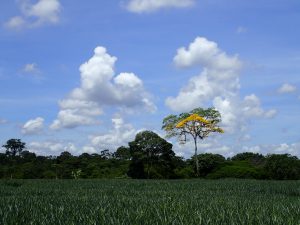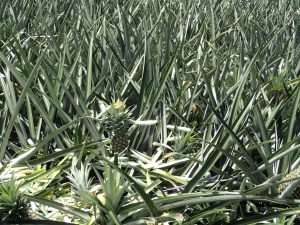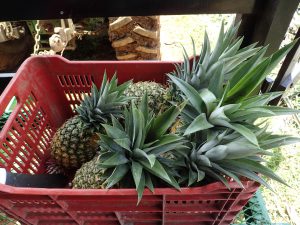
September 7th was a day centered around food (which means it was amazing). Our first stop was a certified organic pineapple farm! After we tried some delicious pineapple juice, we hopped on a large flatbed truck with benches to begin the tour of the farm. Our tour guide said that by the end of the tour we would all be pineapple experts. Costa Rica is the number one exporter of pineapple, and Brazilis the number one producer of pineapple. Costa Rica grows the MD2 hybrid variety of pineapple.
 It is actually quite difficult to grow pineapple on a large farm. Since the pineapple plants are top heavy and have shallow roots, they must be grown close together in order to keep them upright. This creates a field of what appears to be tall, sharp grass sticking out in all directions. But to an ecologist, it looks like a field of bromeliads (which it is). The pineapple plant is a bromeliad, and it will only produce fruit when it is in unfavorable conditions such as a lack of nutrients.
It is actually quite difficult to grow pineapple on a large farm. Since the pineapple plants are top heavy and have shallow roots, they must be grown close together in order to keep them upright. This creates a field of what appears to be tall, sharp grass sticking out in all directions. But to an ecologist, it looks like a field of bromeliads (which it is). The pineapple plant is a bromeliad, and it will only produce fruit when it is in unfavorable conditions such as a lack of nutrients.
This is the reason behind a complicated set of steps to get the plants to produce ripe fruit which can all be harvested at the same time. First the ground is covered with plastic that needs to be replaced every three years. Then the pineapples are planted by hand (approximately 22,000 plants per acre). After 8 months, the plants are sprayed with ethylene gas (signal that causes the plants to produce fruits). After an additional 4 months the plants can be cut and harvested. The plant will produce a second pineapple fruit a year later, but after that a new one needs to be planted. Because pineapple is grown as a monoculture, it is a very intense process that is not good for the natural environment. In order to add more nitrogen to the soil, legumes are planted every few years. Since the farm is organic, they also have some interesting techniques to manage pests. To control flies, they put sticks around the field that have white plastic bags on  them covered with glue. We finished the tour by eating loads more pineapple, pineapple upside down cake, pineapple empanadas, and of course piña coladas! After the tour, we continued eating our way through La Selva by going on a chocolate farm tour.
them covered with glue. We finished the tour by eating loads more pineapple, pineapple upside down cake, pineapple empanadas, and of course piña coladas! After the tour, we continued eating our way through La Selva by going on a chocolate farm tour.
Fun facts:
-Pineapple is a self pollinated composite fruit (which means it’s actually a combination of many fruits
-Pineapples ripen from the bottom to the top (which means the bottom half is always sweeter than the top half)
-Once a pineapple fruit is cut from the plant, it stops ripening and begins to ferment inside
How to buy the perfect pineapple:
The pineapple should be firm on the outside
It should be more green than yellow and have a strong crown of leaves
To test it, hold a leaf on the bottom of the crown (you should be able to hold the pineapple up just from this leaf without it breaking)
As soon as you get home from the store, put the pineapple in the refrigerator
Or if you are entertaining guests, cut the pineapple in half and set out the top half for your friends. Then put the bottom, sweeter half in the refrigerator to save for yourself.

